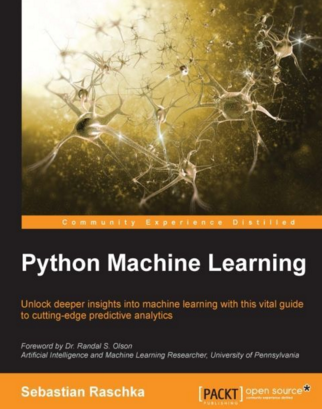Guest blog by Sebastian Raschka, originally posted here.
If we tackle a supervised learning problem, my advice is to start with the simplest hypothesis space first. I.e., try a linear model such as logistic regression. If this doesn’t work “well” (i.e., it doesn’t meet our expectation or performance criterion that we defined earlier), I would move on to the next experiment.
Random Forests vs. SVMs
I would say that random forests are probably THE “worry-free” approach – if such a thing exists in ML: There are no real hyperparameters to tune (maybe except for the number of trees; typically, the more trees we have the better). On the contrary, there are a lot of knobs to be turned in SVMs: Choosing the “right” kernel, regularization penalties, the slack variable, …
Both random forests and SVMs are non-parametric models (i.e., the complexity grows as the number of training samples increases). Training a non-parametric model can thus be more expensive, computationally, compared to a generalized linear model, for example. The more trees we have, the more expensive it is to build a random forest. Also, we can end up with a lot of support vectors in SVMs; in the worst-case scenario, we have as many support vectors as we have samples in the training set. Although, there are multi-class SVMs, the typical implementation for mult-class classification is One-vs.-All; thus, we have to train an SVM for each class — in contrast, decision trees or random forests, which can handle multiple classes out of the box.
To summarize, random forests are much simpler to train for a practitioner; it’s easier to find a good, robust model. The complexity of a random forest grows with the number of trees in the forest, and the number of training samples we have. In SVMs, we typically need to do a fair amount of parameter tuning, and in addition to that, the computational cost grows linearly with the number of classes as well.
Deep Learning
As a rule of thumb, I’d say that SVMs are great for relatively small data sets with fewer outliers. Random forests may require more data but they almost always come up with a pretty robust model. And deep learning algorithms… well, they require “relatively” large datasets to work well, and you also need the infrastructure to train them in reasonable time. Also, deep learning algorithms require much more experience: Setting up a neural network using deep learning algorithms is much more tedious than using an off-the-shelf classifiers such as random forests and SVMs. On the other hand, deep learning really shines when it comes to complex problems such as image classification, natural language processing, and speech recognition. Another advantage is that you have to worry less about the feature engineering part. Again, in practice, the decision which classifier to choose really depends on your dataset and the general complexity of the problem — that’s where your experience as machine learning practitioner kicks in.
If it comes to predictive performance, there are cases where SVMs do better than random forests and vice versa:
- Caruana, Rich, and Alexandru Niculescu-Mizil. “An empirical comparison of supervised learning algorithms.” Proceedings of the 23rd international conference on Machine learning. ACM, 2006.
The same is true for deep learning algorithms if you look at the MNIST benchmarks (http://yann.lecun.com/exdb/mnist/): The best-performing model in this set is a committee consisting of 35 ConvNets, which were reported to have a 0.23% test error; the best SVM model has a test error of 0.56%. The ConvNet ensemble may reach a better accuracy (for the sake of this ensemble, let’s pretend that these are totally unbiased estimates), but without a question, I’d say that the 35 ConvNet committee is far more expensive (computationally). So, if you make that decision: Is a 0.33% improvement worth it? In some cases, it’s maybe worth it (e.g., in the financial sector for non-real time predictions), in other cases it perhaps won’t be worth it, though.
So, my practical advice is:
- Define a performance metric to evaluate your model
- Ask yourself: What performance score is desired, what hardware is required, what is the project deadline
- Start with the simplest model
- If you don’t meet your expected goal, try more complex models (if possible)
About the Author
Sebastian Raschka is the author of the bestselling book “Python Machine Learning.” As a Ph.D. candidate at Michigan State University, he is developing new computational methods in the field of computational biology. Sebastian has many years of experience with coding in Python and has given several seminars on the practical applications of data science and machine learning. Sebastian loves to write and talk about data science, machine learning, and Python, and he is really motivated to help people developing data-driven solutions without necessarily requiring a machine learning background.
Sebastian is also actively contributing to open source projects, and methods that he implemented are now successfully used in machine learning competitions such as Kaggle. In his free-time, Sebastian is also working on models for sports predictions, and if he is not sitting in front of a computer, he enjoys playing sports in his spare time.
DSC Resources
- Career: Training | Books | Cheat Sheet | Apprenticeship | Certification | Salary Surveys | Jobs
- Knowledge: Research | Competitions | Webinars | Our Book | Members Only | Search DSC
- Buzz: Business News | Announcements | Events | RSS Feeds
- Misc: Top Links | Code Snippets | External Resources | Best Blogs | Subscribe | For Bloggers
Additional Reading
- What statisticians think about data scientists
- Data Science Compared to 16 Analytic Disciplines
- 10 types of data scientists
- 91 job interview questions for data scientists
- 50 Questions to Test True Data Science Knowledge
- 24 Uses of Statistical Modeling
- 21 data science systems used by Amazon to operate its business
- Top 20 Big Data Experts to Follow (Includes Scoring Algorithm)
- 5 Data Science Leaders Share their Predictions for 2016 and Beyond
- 50 Articles about Hadoop and Related Topics
- 10 Modern Statistical Concepts Discovered by Data Scientists
- Top data science keywords on DSC
- 4 easy steps to becoming a data scientist
- 22 tips for better data science
- How to detect spurious correlations, and how to find the real ones
- 17 short tutorials all data scientists should read (and practice)
- High versus low-level data science
Follow us on Twitter: @DataScienceCtrl | @AnalyticBridge


